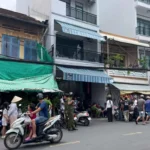Ho Chi Minh City Police determine the initial cause of the fire at Doc Lap apartment complex was an electrical short in the wiring connected to a clothes dryer and refrigerator, placed in the outdoor area.
Details regarding the Doc Lap apartment fire were provided by Major General Nguyen Thanh Huong, deputy director of Ho Chi Minh City Police, during a press conference on the city’s socio-economic situation on the afternoon of July 10.
“The preliminary cause of the fire has been identified as an electrical short. Specifically, it originated from the wiring connected to a clothes dryer and refrigerator… placed in an encroached and enclosed outdoor space. This area also contained cars and motorcycles,” said Major General Nguyen Thanh Huong.
He also emphasized that Doc Lap is an old-style apartment complex that has existed for many years. Many similar buildings have fire prevention and fighting systems (PCCC), but they have deteriorated, with many devices damaged beyond use. Meanwhile, most old apartment buildings lack maintenance funds to repair or replace PCCC equipment.
According to statistics, Ho Chi Minh City has 1,132 apartment buildings, including 239 apartments and 341 blocks built before 1975, along with hundreds of other structures built between 1975 and 2001. Many of these pose potential fire safety risks.
Commonly seen in these old apartment buildings are cramped living conditions, with extensions and enclosures… creating latent fire hazards. Numerous city documents and recommendations have warned about this issue.
According to Huong, to minimize fire risks, management of flammable materials and heat sources in daily living is essential. If flammable materials are limited during a fire, damage can be reduced… but awareness and skills are most crucial.
“Distant water cannot save a nearby fire—fires spread in seconds…” Huong said, urging residents to raise awareness.
For old apartment complexes, Ho Chi Minh City Police have advised the People’s Committee to issue multiple regulations to ensure fire safety. Simultaneously, public awareness campaigns have been conducted continuously in collaboration with relevant agencies.
Doc Lap apartment fire claims 8 lives
According to Ho Chi Minh City Police, at 9:54 PM on July 6, the Fire Prevention, Fighting, Rescue, and Disaster Response Division received reports of a fire at Doc Lap apartment complex in Phu Tho Hoa Ward, Ho Chi Minh City.
The division quickly deployed personnel and vehicles to the scene… The fire was extinguished by 10:10 PM the same day and contained to prevent spreading. Three people were safely rescued.
The aftermath resulted in eight fatalities and partial damage to the apartment, along with some household items and vehicles.
Ho Chi Minh City Party Committee Secretary Nguyen Van Nen visited the funeral at Vinh Nghiem Pagoda to offer condolences to the families of the eight victims.






